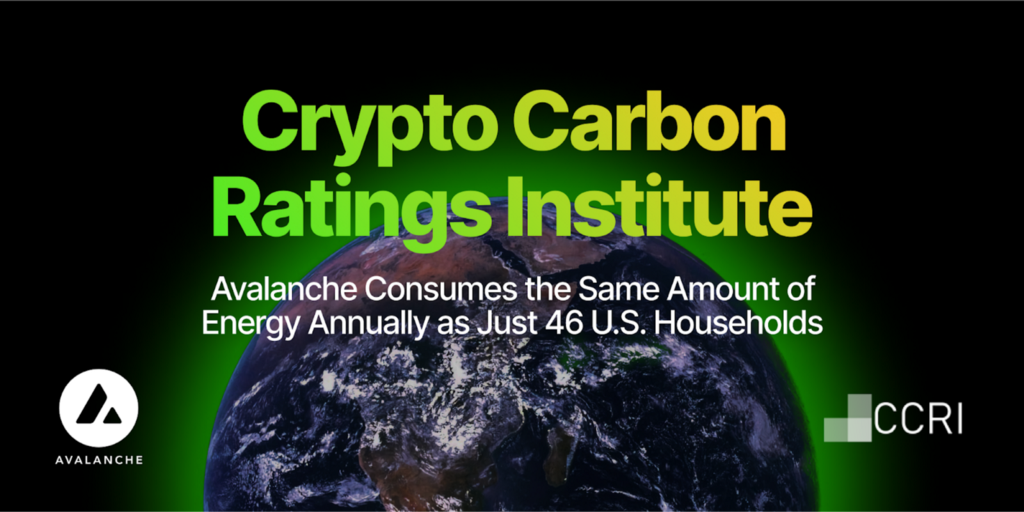CCRI Finds Avalanche to Consume 35,000x Less Energy Than Ethereum and 200,000x Less Than Bitcoin
The Crypto Carbon Ratings Institute (CCRI) a renowned company in the field of crypto-related climate impact, has systematically assessed the carbon efficiency of six leading proof-of-stake networks and their proof-of-work counterparts

The Crypto Carbon Ratings Institute (CCRI), a research company focused on the environmental impact of cryptocurrencies, today released research which finds the Avalanche public blockchain to use just 0.0005% of the amount of energy consumed by the Bitcoin blockchain, and only 0.0028% of that of the Ethereum network.
The findings were released in the Energy Efficiency and Carbon Footprint of Proof-of-Stake Blockchain Protocols Report by CCRI. The report analyzes the energy consumption and carbon footprint of six proof-of-stake networks, including Avalanche (AVAX), Algorand (ALGO), Cardano (ADA), Polkadot (DOT), Tezos (XTZ), and Solana (SOL), as well as proof-of-work networks, Bitcoin (BTC) and Ethereum (ETH).
The report found Bitcoin to consume the same energy as 8.5 million U.S. households in a given year, while Ethereum consumes the equivalent of 1.6 million U.S. households. By contrast, the Avalanche network was found to consume the same amount of energy as only 46 US households. The average U.S. household consumes 10,600 kWh per year.
Per the report, the overall rankings produced for the total energy consumption of each network are as follows: Polkadot (70,237 kWh), Tezos (94,120 kWh), Avalanche (489,311 kWh), Algorand (512,671 kWh), Cardano (598,755 kWh), Solana (1,967,930 kWh), Ethereum (17,300,000,000 kWh) and lastly, Bitcoin (89,780,000,000 kWh).
When assessing the economic value secured in financial applications on each platform (“total value locked”), the differentiation between networks’ energy efficiency becomes more stark. Avalanche secures $18,454 in total value locked on the network per kWh, as compared to $4,395 per kWh on Solana, $943 per kWh on Tezos, $161 on Algorand, and $120 per kWh on Cardano, and $19.18 per kWh for Polkadot. Total value locked data according to DeFiLlama as of February 1, 2022.
“It is negligent to ignore the potentially massive impact engineering and business decisions made by Web3 builders today can have on the generations to come,” said Emin Gün Sirer, CEO of Ava Labs. “This research shows that every person who chooses to deploy an asset or application on Avalanche can simultaneously build a better financial system and participate in a solution to the climate crisis.”
This report joins a body of research produced by CCRI on the environmental impact of cryptocurrencies and blockchain platforms, including reports commissioned by institutional investors with climate justice as a core component of their investment theses.
“Electricity-intense Proof-of-Work protocols have largely coined the environmental image of blockchain networks in the public perception. It is, however, essential to differentiate among blockchain protocols as environmental impacts greatly vary.” said Ulrich Gallersdörfer, CEO of CCRI. “This study empirically underpins that Proof-of-Stake protocols, such as the one used by the Avalanche, consume only a tiny fraction of electricity in the validation process of transactions and ownership compared to protocols such as Bitcoin.”
The CCRI research methodology analyzed multiple factors, including the network size, varying hardware configuration, and network infrastructure. Based on the total emissions calculated for these six networks, one may conclude that proof-of-stake-based blockchain protocols consume an amount of energy that does not justify the discussions about their environmental footprints.
For practitioners selecting a proof-of-stake blockchain protocol, other factors such as decentralization, network throughput or functionality (ie. smart contracts) should increase in relevance as a decision criteria.
Please visit CCRI to view the full report.
About CCRI
The Crypto Carbon Ratings Institute (CCRI) provides carbon estimates for investments in cryptocurrencies and technologies such as Blockchain and distributed ledger technologies (DLT). We have built a multi-year research track record with a specific focus on Bitcoin and its environmental impacts. We published comprehensive and formerly peer-reviewed studies on Bitcoin’s carbon footprint in the renowned scientific journals. Our research has been covered by major media outlets, such as CNN and The New York Times, and has been appraised as very good estimate by major organizations, such as the IEA.
About Avalanche
Avalanche is the fastest smart contracts platform in the blockchain industry, as measured by time-to-finality. Avalanche is blazingly fast, low cost, and eco-friendly. Any smart contract-enabled application can outperform its competition by deploying on Avalanche. Don’t believe it? Try an app on Avalanche today.
![]()
CCRI Finds Avalanche to Consume 35,000x Less Energy Than Ethereum and 200,000x Less Than Bitcoin was originally published in Avalanche on Medium, where people are continuing the conversation by highlighting and responding to this story.


